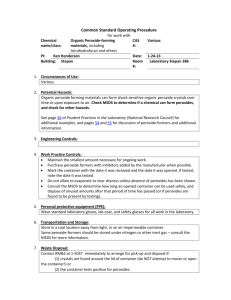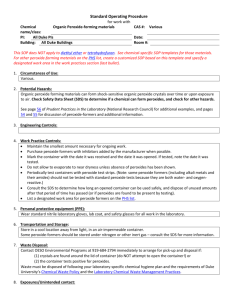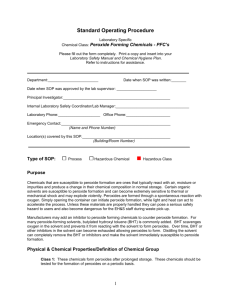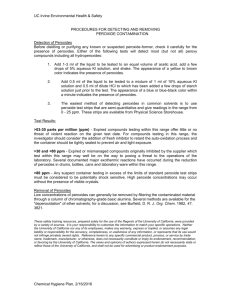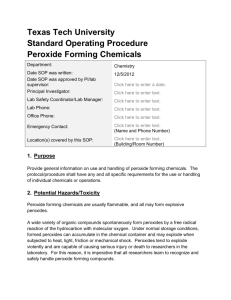Styrene SOP
advertisement
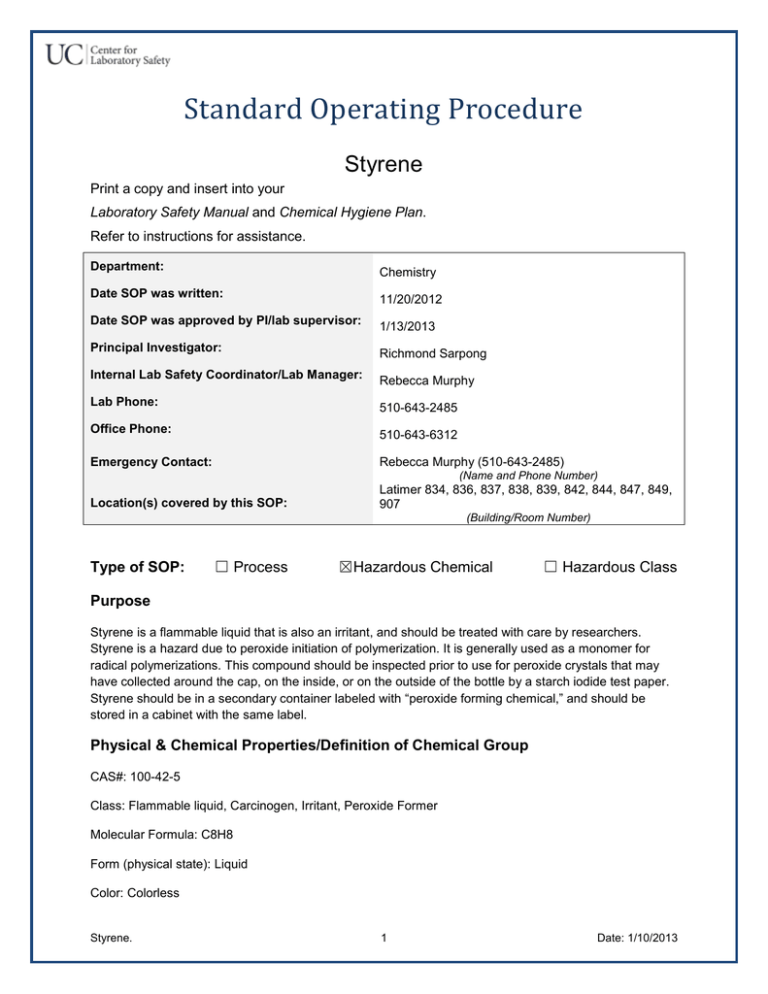
Standard Operating Procedure Styrene Print a copy and insert into your Laboratory Safety Manual and Chemical Hygiene Plan. Refer to instructions for assistance. Department: Chemistry Date SOP was written: 11/20/2012 Date SOP was approved by PI/lab supervisor: Principal Investigator: Richmond Sarpong Internal Lab Safety Coordinator/Lab Manager: Lab Phone: 1/13/2013 Rebecca Murphy 510-643-2485 Office Phone: 510-643-6312 Emergency Contact: Rebecca Murphy (510-643-2485) Location(s) covered by this SOP: Latimer 834, 836, 837, 838, 839, 842, 844, 847, 849, 907 (Name and Phone Number) (Building/Room Number) Type of SOP: ☐ Process ☒Hazardous Chemical ☐ Hazardous Class Purpose Styrene is a flammable liquid that is also an irritant, and should be treated with care by researchers. Styrene is a hazard due to peroxide initiation of polymerization. It is generally used as a monomer for radical polymerizations. This compound should be inspected prior to use for peroxide crystals that may have collected around the cap, on the inside, or on the outside of the bottle by a starch iodide test paper. Styrene should be in a secondary container labeled with “peroxide forming chemical,” and should be stored in a cabinet with the same label. Physical & Chemical Properties/Definition of Chemical Group CAS#: 100-42-5 Class: Flammable liquid, Carcinogen, Irritant, Peroxide Former Molecular Formula: C8H8 Form (physical state): Liquid Color: Colorless Styrene. 1 Date: 1/10/2013 Boiling point: 145 - 146 °C Flash Point: 31oC (88oF) Closed Cup Potential Hazards/Toxicity Acute toxicity Oral LD50 LD50 Oral - rat - 2,650 mg/kg Remarks: Behavioral:Somnolence (general depressed activity). Liver:Other changes. Inhalation LC50 LC50 Inhalation - rat - 4 h - 12,000 mg/m3 Skin corrosion/irritation Skin - rabbit - Skin irritation Serious eye damage/eye irritation Eyes - rabbit - Eye irritation - 24 h Germ cell mutagenicity Laboratory experiments have shown mutagenic effects. Cal-OSHA Permissible Exposure Limit (PEL): 50 ppm (210 mg/m 3) Engineering Controls NOTE: Lab-specific information on engineering controls may be included in the Protocol/Procedure section. Work with styrene should be conducted in a fume hood. Sash height should be kept low to avoid escaping fumes. Use explosion proof equipment like a blast shield to protect from explosions in the case of peroxide detonation. Personal Protective Equipment (PPE) NOTE: Lab-specific information on PPE selection may be included in the Protocol/Procedure section. Respiratory Protection NOTE: Lab personnel intending to use/wear a respirator mask must be trained and fit-tested by EH&S. This is a regulatory requirement. Respirators should be used only under any of the following circumstances: As a last line of defense (i.e., after engineering and administrative controls have been exhausted). When Permissible Exposure Limit (PEL) has exceeded or when there is a possibility that PEL will be exceeded. Regulations require the use of a respirator. An employer requires the use of a respirator. There is potential for harmful exposure due to an atmospheric contaminant (in the absence of PEL) As PPE in the event of a chemical spill clean-up process Styrene. 2 Date: 1/10/2013 Hand Protection Gloves must be worn with when handling peroxide-forming chemicals. Gloves must be inspected prior to use. Use proper glove removal technique (without touching glove's outer surface) to avoid skin contact with this product. Wash and dry hands. NOTE: Lab-specific and chemical-specific information on glove selection may be included in the Protocol/Procedure section. Refer to glove selection from the link below: For glove selection, go to: http://ehs.berkeley.edu/hs/63-laboratory-safety/94-glove-selection-andusage.html Eye Protection Safety glasses with side shields or tightly fitting safety goggles. Use goggles and face shield (8inch minimum) when appropriate. Only use equipment for eye protection tested and approved under appropriate government standards such as ANSI Z 87.1, NIOSH (US), or EN 166(EU). Skin and Body Protection Long pants, closed-toed and closed-heeled shoes, cotton-based clothing/attire (no exposed skin below waist), and flame resistant lab coat must be worn for protecting against chemical hazards. No exposed skin is allowed from waist down. Hygiene Measures Handle in accordance with good industrial hygiene and safety practice. Wash hands before breaks and at the end of workday. First Aid Procedures Notify supervisor and EH&S immediately. Follow up with a call to 510-642-9090 to report the incident. Refer to specific chemical SOPs and SDSs for specific first aid procedures. General First Aid Procedures If inhaled If breathed in, move person into fresh air. If not breathing, give artificial respiration. Immediately seek medical attention. In case of skin contact Remove contaminated clothing. Wash off with soap and plenty of water. Seek medical attention. Styrene. 3 Date: 1/10/2013 In case of eye contact Rinse thoroughly with plenty of water using an emergency eyewash station for at least 15 minutes and seek medical attention. If swallowed Do NOT induce vomiting unless directed otherwise by the SDS. Never give anything by mouth to an unconscious person. Rinse mouth with water. Seek medical attention. Special Handling and Storage Requirements NOTE: Laboratory-specific information on handling and storage may be included in the Protocol/Procedure section. Refer to specific chemical SOPs and SDSs for specific handling and storage requirements. Working alone Certain extremely hazardous operations should not be performed if the PI or Lab Safety Contact(s) are not present. Never work alone with extremely hazardous materials/operations. See the Protocol/Procedure section for specific prohibitions (if any) on working alone. Precautions for Safe Handling Avoid contact with skin and eyes. Avoid inhalation of vapor or mist. Keep away from sources of ignition No smoking. Take measures to prevent the build up of electrostatic charge. Conditions for safe storage Keep container tightly closed in a dry and well-ventilated place. Containers that are opened must be carefully resealed and kept upright to prevent leakage. Recommended storage temperature: 2 - 8 °C Light sensitive. If peroxide crystals are found on the outside of the container, DO NOT MOVE. Contact EH&S for hazardous waste pickup. Safe handling practices and procedures involve making effective purchasing decisions, implementing a storage control program, periodic testing for peroxides, and proper disposal of hazardous containers. These elements are described below and are also presented in summary format in Table 2. General Precautions Minimize the quantity of peroxides or peroxide forming chemicals in the lab. Label each container with the Date Received, Date Opened and Date Last Tested. Segregate these compounds from incompatible materials. Store away from ignition sources. Protect from flames, static electricity, and sources of heat. Test chemicals for peroxide before any distillation or purification of peroxide forming chemicals. Styrene. 4 Date: 1/10/2013 NEVER distill potential peroxide-forming chemicals to dryness. Always leave a minimum of 20% still bottoms. When possible, add a non-volatile organic compound (such as mineral oil) to dilute any peroxides remaining after distillation. Use extreme caution before concentrating or purifying peroxide forming chemicals as most explosions occur during these processes. Wear proper personal protective equipment, including safety eyewear and face shields, when working with peroxide forming chemicals. Minimize peroxide formation in ethers by storing in tightly sealed containers in a cool place in the absence of light. If solids or crystals are observed in either the liquid or around the cap of peroxide forming chemicals, do not open or move the container but contact EH&S for disposal. Visual Inspection: Visually inspect all peroxide-forming chemicals before any operation. Containers that exhibit any unusual visual characteristics, such as the examples listed below, should be assumed to contain dangerous levels of peroxides and should not be disturbed. Notify EH&S, who will assist in the further evaluation. If there is any doubt about the safety of handling a chemical container, notify EH&S immediately. For liquid chemicals, look for crystallization (around the cap or in the liquid), visible discoloration, or liquid stratification. Diethyl ether is commonly sold in steel containers which prevents visual inspection of the liquid. Therefore, diethyl ether containers whose age and use history are unknown should be assumed to contain dangerous levels of peroxides and should not be disturbed. Materials not passing visual inspection are considered to be high risk and will have to be disposed of by special means (limit handling and movement; notify EH&S). Only chemicals that pass visual inspection should be tested. Testing for Peroxides Note: Never try to force open a rusted or stuck cap on a container of a peroxide-forming chemical. There is a great deal of uncertainty regarding the concentration at which peroxides pose a hazard to researchers. Various sources suggest that the minimum hazardous concentration of peroxides in organic solution is in the range 0.005 - 1.0% (50-10000 PPM). In most safety literature, a conservative concentration of 100 PPM peroxides is used as a control point. Styrene. 5 Date: 1/10/2013 By the end of the expiration date (as indicated in Table 2) for a particular peroxide forming chemical, the person using the chemical should either dispose of it or test it for peroxide content. Any container found to have a peroxide concentration greater than or equal to 100 PPM should be disposed of (call EHS&S for assistance). Materials which are older than the suggested shelf life but have been tested and have no detectable peroxides or peroxide concentrations less than 100 PPM may be retained but should be tested at frequent intervals (see Table 2). All chemicals which are to be distilled must be tested prior to distillation regardless of age. Important note: Researchers should never test containers of unknown age or origin. Older containers are far more likely to have concentrated peroxides or peroxide crystallization in the cap threads and therefore can present a serious hazard when opened for testing. Please read section below on managing older containers. INSERT #17 There are several methods that are commonly used to detect for peroxides in the laboratory. Perhaps the most convenient method is the use of peroxide test strips which are manufactured by Aldrich and several other suppliers. These strips are simple to use and can be obtained from EHS&S. For volatile organic chemicals, the test strip is immersed in the chemical for 1 second; then the tester breathes slowly on the strip for 1530 seconds or until the color stabilizes. The color is then compared with a colorimetric scale provided on the bottle. Strips that offer a 1-100 PPM peroxide range are useful for determining if the material is below the control point of 100 PPM. Other testing methods are available. Contact EHS&S for more information. Purchasing INSERT #17 Ideally, purchases of peroxide-forming chemicals should be restricted to ensure that these chemicals are used up completely before they can become peroxidized. This requires careful experiment planning on behalf of researchers. Researchers should purchase no more material than is needed to complete an experiment within the chemical’s safe shelf life. Storage and Shelf Life Peroxides tend to form in materials as a function of age. Therefore, it is imperative that researchers are keenly aware of the age of their peroxide forming chemicals. Researchers must date each container of peroxide-forming chemical upon arrival in the laboratory. Containers must be dated again when opened for the first time. Additional dates of testing should be added in certain cases (see below). Special labels as Styrene. 6 Date: 1/10/2013 depicted below make dating of the containers convenient. These labels are available free of charge from EHS&S. Table 2 lists the safe shelf life of the different classes of peroxideforming compounds. Suggested time limits are given for retention or testing of these compounds. However, it must be noted that these shelf life durations are minimum criteria; many other references recommend more frequent testing for peroxides. Peroxide forming chemicals should be stored in their original manufacturer’s container whenever possible. This is very important in the case of diethyl ether because the iron in the steel containers that this material is shipped in acts as a peroxide inhibitor. In general, peroxide-forming chemicals should be stored in sealed, airimpermeable containers and should be kept away from light (light can initiate peroxide formation). Dark amber glass with a tight fitting cap is appropriate Table 2--Safe storage period for peroxide-forming chemicals Peroxidizable Chemical Classification Dispose or Test After1 •Unopened chemicals from the manufacturer : 18 months •Opened containers List A, Table 1 materials: 3 months List B, Table 1 materials: 12 months Uninhibited List C, Table 1 materials: 24 hours Inhibited List C, Table 1 materials: 12 months2 (Footnotes) 1 Never open or test containers of unknown origin or age or that have visible evidence of peroxides! 2 Do not store under inert atmosphere INSERT #17 Styrene. 7 Date: 1/10/2013 Label for Peroxide-Forming Chemicals Warning: May Form Explosive Peroxides Store in tightly closed original container. Avoid exposure to light, air and heat. If crystals, discoloration or layering is visible, do not move or open and contact EHS&S immediately. Check for peroxides before distilling or concentrating. This Chemical has a limited shelf life! Date Received Date Opened Test or dispose months after receipt or months after opening. Do not use chemical if >100 PPM peroxides are detected. Test date Peroxides PPM Spill Response and Exposure Response Before beginning work with chemicals, review the relevant SOPs, Safety Data Sheets, and other chemical safety resources. Develop specific procedures for emergency response and chemical exposure or injury to staff, including any special first aid measures required for the relevant chemicals. Spill and Accident Procedure Note: These responses may not apply to all peroxide-forming toxic chemicals. Please review specific chemical SOPs and SDSs for specific response to spills and accidents. Always dial 911 and 510-642-9090 for assistance. Chemical Spill Dial 911 Spill – Assess the extent of danger. Help contaminated or injured persons. Evacuate the spill area. Avoid breathing vapors. If possible, confine the spill to a small area using a spill kit or absorbent material. Keep others from entering contaminated area (e.g., use caution tape, barriers, etc.). Dial 911 and 510-642-9090 for assistance. Chemical Spill on Body or Clothes – Remove clothing and rinse body thoroughly in emergency shower for at least 15 minutes. Seek medical attention. Notify supervisor and EH&S immediately. Follow up with a call to 510-642-9090 to report the incident. Chemical Splash Into Eyes – Immediately rinse eyeball and inner surface of eyelid with water from the emergency eyewash station for 15 minutes by forcibly holding the eye open. Seek medical attention. Notify supervisor and EH&S immediately. Follow up with a call to 510-6429090 to report the incident. Styrene. 8 Date: 1/10/2013 Medical Emergency Dial 911 Life Threatening Emergency, After Hours, Weekends And Holidays – Dial 911 or go to the nearest emergency room. Note: All serious injuries must be reported to EH&S within 8 hours. Follow up with a call to 510-642-9090 to report the incident. Non-Life Threatening Emergency – Go to the Occupational Health Facility (Tang Health Center). After hours go to the nearest emergency room. Note: All serious injuries must be reported to EH&S within 8 hours. Follow up with a call to 510-642-9090 to report the incident. Needle stick/puncture exposure (as applicable to chemical handling procedure) – Wash the affected area with antiseptic soap and warm water for 15 minutes. For mucous membrane exposure, flush the affected area for 15 minutes using an eyewash station. Go to the Occupational Health Facility (Tang Health Center). After hours go to the nearest emergency room. Note: All needle stick/puncture exposures must be reported to EH&S within 8 hours. Follow up with a call to 510-642-9090 to report the incident. Hazardous Waste Disposal General hazardous waste disposal guidelines: Label Waste Label all containers with the label provided at http://ehs.berkeley.edu/hm/279-newhazardous-waste-program-hwp.html. See the EH&S Fact Sheet, “Hazardous Waste Management” for general instructions on procedures for disposing of hazardous waste. Dispose of Waste Dispose of regularly generated chemical waste within 6 months. Call EH&S for questions. Management and disposal of old containers Older containers of peroxidizable chemicals, or containers of unknown age or history, must be handled very carefully and should never be opened by researchers. Any peroxidizable chemical with visible discoloration, crystallization or liquid stratification should be treated as potentially explosive. Older steel containers that have visible rust may also be extremely dangerous. If any of these conditions are observed on a peroxidizable chemical or if the origin and age of the container are unknown, do not attempt to move or open the container. Please call EHS&S for assistance. We will arrange to have the container(s) inspected and if necessary will arrange for disposal. Styrene. 9 Date: 1/10/2013 Safety Data Sheet (SDS) Location SDS can be accessed online at http://ucmsds.com Styrene. 10 Date: 1/10/2013 Protocol/Procedure for Styrene CAS#: 100-42-5 Preparation List any other particular preparation requirements needs for this procedure (e.g., location of spill kit or keep water or ignition sources away from procedure area). Know the location of the nearest fire extinguisher, eyewash, and safety shower before beginning work. Lab-specific Information Add lab-specific information not included above if needed (e.g., all work for this procedure is to take place in the designated fume hood.) Procedure/Use 1. As a reagent/ligand. Scale Up to 1 L of styrene. Engineering Controls/Equipm ent Preparation of reaction mixtures containing styrene should be done in a fume hood. PPE (eye, face, gloves, clothing) Eye protection: Wear tight-fitting safety goggles or safety glasses with side shields. Face protection: Wear a face shield. Gloves: Wear reusable rubber, nitrile, or neoprene gloves. Clothing: Wear lab coat; full length pants or equivalent; and close-toed and closeheeled shoes. Notes Initials of individuals using this procedure Styrene. Any deviation from this SOP requires approval from PI. 11 Date: 1/10/2013 Procedure Steps and Precautions In a fume hood, add styrene via syringe, or by a slow pour if using larger amounts, to reaction vessel containing a magnetic stir bar or overhead stirring mechanism. Once reaction is complete, dispose of all waste properly (see disposal of waste above). Documentation of Training (signature and initials of all users is required) Prior to conducting any work with Styrene, designated personnel must provide training to his/her laboratory personnel specific to the hazards involved in working with the specific chemical(s) used, work area decontamination, and emergency procedures. The Principal Investigator must provide his/her laboratory personnel with a copy of this SOP and a copy of the SDS provided by the manufacturer. I have read and understand the content of this SOP: Name Signature Initials Click here to enter text. Date Click here to enter a date. Click here to enter a date. Click here to enter a date. Click here to enter a date. Click here to enter a date. Click here to enter a date. Click here to enter a date. Click here to enter a date. Click here to enter a date. Click here to enter a date. Click here to enter a date. Click here to enter a date. Click here to enter a date. Click here to enter a date. Click here to enter a date. Click here to enter text. Click here to enter text. Click here to enter text. Click here to enter text. Click here to enter text. Click here to enter text. Click here to enter text. Click here to enter text. Click here to enter text. Click here to enter text. Click here to enter text. Click here to enter text. Click here to enter text. Click here to enter text. Styrene. Identification 12 Date: 1/10/2013
